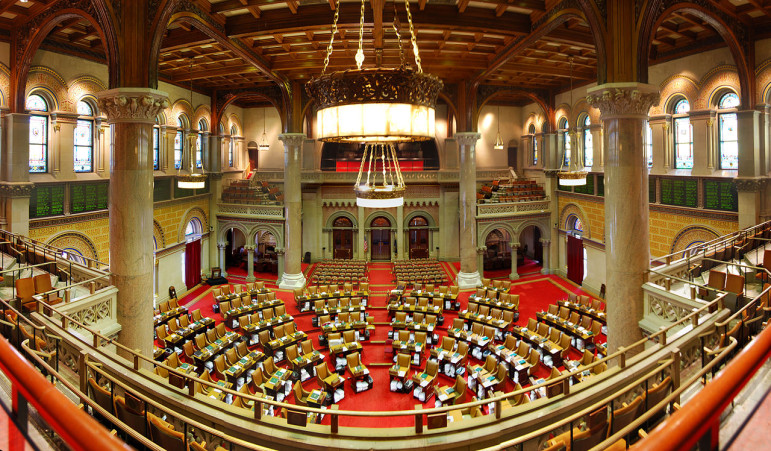
The New York State Assembly chamber. Get your seats now for round 2 of the 421-a debate.
There was a time not long ago when those in the know expected New York’s rent regulations to be extended in exchange for renewal of the controversial 421-a tax exemption. After all, its happened in the past, and since downstate Democrats want the rent-regs extension while upstate Republicans want 421-a continued, a straight swap, whether it was good public policy or not, seemed likely.
But that was then, before a detour for consideration of the education tax credit for public and religious schools advocated by Governor Andrew Cuomo, and a debate over a prevailing wage provision for 421-a that pitted Mayor de Blasio against the governor and several unions.
Though there was once momentum to allow 421-a to lapse—especially after developers who benefit mightily from it figured into questions about corruption and Cuomo’s decision to disband the Moreland Commission—that movement fizzled earlier this year when de Blasio signaled he would continue to rely on private developers to create “affordable” housing, though with different terms for the city.
Then came the debate about prevailing wages, creating interesting bedfellows. The union-friendly mayor joined with the Real Estate Board of New York in resisting a wage rule, arguing that no affordable housing would be created because the requirement would simply make building too costly. On the other side, the governor aligned with other elected officials and unions, ironic given Cuomo’s terrible relationship with organized labor. Another irony: Cuomo took on the prevailing wage cause late in the game only to blame last-minute demands for preventing an agreement on reform.
The smart money now seems to be on a very short extender, maybe three to six months or a year, meaning we’re very likely to be right back here in December or next June. And here are some of the issues and debates we’ll have to deal with then, even if they do get glossed over now:
1) The program’s cost and efficacy, including how some developers “double dip”: get other tax breaks simultaneously and counting the same units more than once.
2) The old question: Affordable for whom? Because the area median income on which 421-a eligibility is based is skewed upward by the inclusion of the entire metropolitan area, developers are given more leeway to build units not for the New Yorkers who need them most. Moreover, de Blasio’s 421-a reform package would include families with incomes as high as $138,000 among those eligible on some projects.
3) The city said its changes to 421-a would cost $10 billion over 45 years. Officials wanted to rely on recouping money from a “mansion” tax, though its passage in Albany is doubtful.
4) Even with the mayor’s modification, the “affordable” units created will not remain so forever. And expiring affordability contracts are a big factor in our current housing crunch.
On Thursday, the state AFL-CIO’s executive council unanimously adopted a resolution backing the prevailing wage’s use in all 421a projects. “Today’s vote by our Executive Council sends a powerful message,” said Mario Cilento, President of the New York State AFL-CIO. “The labor movement is speaking with one very clear voice that there must be a return on the taxpayer’s investment, and in this case that return for giving developers more than $1 billion a year in tax breaks needs to be the creation of good jobs.”
Also yesterday, CrainsNY reported the city could lose 1,300 apartment if Albany extends 421a as is. Using IBO data, Crain’s wrote that in 83 percent of the city, projects can get the tax breaks without providing affordable units, whereas de Blasio’s plan requires such units in every future 421-a projects. According to the article, “the changes would cost $2.7 billion more [each year] … than the existing price tag of $7.2 billion … but would generate nearly 25,000 affordable units—roughly double” of what is currently produced. However, Crains reports advocacy groups “have questioned how many units will actually be affordable,” and the IBO failed to examine the affects of 421-a on neighborhoods and resulting primary and secondary displacement.
City Limits coverage of public housing and New York’s rental affordability crisis is supported by the Charles H. Revson Foundation.








